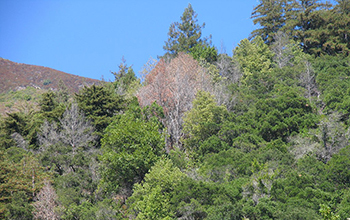
Research News
Long-term data help determine fluctuations in fish populations
November 30, 2015
The following is part 20 in a series on the National Science Foundation’s Long-Term Ecological Research (LTER) Network. Visit parts one, two, three, four, five, six, seven, eight, nine, 10,11, 12,13, 14, 15, 16, 17, 18 and 19.
For years, scientific literature, as well as fisheries management and conservation efforts, has assumed that the survival of adult fish is relatively constant through time, and that most fluctuations in the numbers of adults come from variation in the number of young fish that are produced and survive to maturity.
However, new research reveals that fluctuating food supplies and competition can alter the survival of adult fish — at least for a Pacific marine reef species — and be a major cause of changes in their populations.
In the study, biologists Daniel Okamoto, Russell Schmitt and Sally Holbrook of the University of California, Santa Barbara, analyzed fish records collected over more than a quarter of a century.
Black surfperch survival
The analyses showed that for black surfperch (Embiotoca jacksoni), survival of adults from year to year was strongly linked with both the amount of prey available and the number of fish sharing that food source. The findings appear this week in the journal Ecology Letters.
“We found that the survival rate varies through time, and is driven by local-scale processes of food variability and competition for that food supply,” said lead paper author Okamoto, now at Simon Fraser University in British Columbia. “That can have major implications for how we think about the effect of fishing on fish populations.
“Mortality from fishing and other human activities can greatly increase fluctuations in the number of fish in a population over time. That runs counter to management and conservation goals for harvested species.”
The time series used in the synthesis came from the National Science Foundation’s (NSF) Santa Barbara Coastal Long-Term Ecological Research (LTER) site. The facility is part of NSF’s LTER Network, funded by its Divisions of Environmental Biology, Ocean Sciences and Polar Programs.
Schmitt and Holbrook began surveying the food supply of surfperch on Santa Cruz Island in the early 1980s. Year after year, they returned to the same locations and surveyed the surfperch and their prey, their habitat and different age classes of the fish.
Time series data
“We wanted to know how much the food supply influenced the population dynamics of fish,” Schmitt said. “While everyone knows that food matters, we were surprised at how important it was compared with other causes of variation in the number of adult fish on a reef.”
LTER data help scientists understand interactions among species. Okamoto used the data to perform sophisticated statistical modeling of fish populations, and examined interactions among the survival rate, the number of fish present and the abundance of their food.
“There were strong interactions among the amount of food and the fishes’ survival rate as well as the number of fish,” Okamoto said. “More fish lead to less survival because they’re competing for limited prey resources.”
Applicable results
Although the study targeted a single species, the research generalized the results for other fish populations.
“The degree to which survival rates vary through time is huge compared to what people expect in fish populations in the ocean,” Okamoto said.
Added Holbrook, “It’s known that fish species that are harvested tend to fluctuate much more through time compared with species that are not fished, and scientists have speculated about what could cause fishing to increase population fluctuations. Our analyses provide a mechanism by which mortality from fishing and other sources can destabilize a fish population.”
Long-term studies, Okamoto said, which look at the processes that give rise to variability affect how we think about sustainable fisheries and conservation measures.
“We suggest adopting precautionary approaches in fisheries until more is known about the complex relationships that shape fish population dynamics,” Schmitt said.
—
Cheryl Dybas,
NSF
(703) 292-7734 cdybas@nsf.gov
—
Julie Cohen,
UCSB
(805) 893-7220 julie.cohen@ucsb.edu
-
Kelp habitat in which black surfperch hunt for prey at Santa Cruz Island, California.
Credit and Larger Version -
Denizen of a giant kelp forest: the black surfperch.
Credit and Larger Version -
The macroalgae Gelidium robustum is a key habitat in which black surfperch live.
Credit and Larger Version -
Black surfperch eat the small organisms living on macroalgae such as these skeleton shrimp.
Credit and Larger Version -
Black surfperch feast on isopods, like this one on a blade of kelp, and other small crustaceans.
Credit and Larger Version
Investigators
Daniel Reed
John Melack
David Siegel
Sally Holbrook
Related Institutions/Organizations
University of California-Santa Barbara
Related Awards
#1232779 LTER: Land/Ocean Interactions and the Dynamics of Kelp Forest Ecosystems (SBC III)
Total Grants
$3,281,158
Related Websites
NSF Santa Barbara Coastal LTER Site: http://sbc.lternet.edu/












